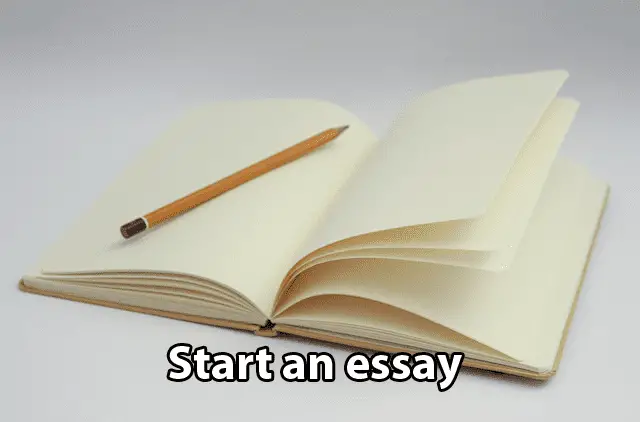
Understanding the essay prompt: Explore the key elements of the essay prompt to gain clarity on the topic and requirements.
Understanding the essay prompt is crucial for successfully completing an essay. By exploring the key elements of the prompt, you can gain clarity on the topic and requirements. This involves carefully analyzing the question or statement provided, identifying any specific instructions or guidelines, and determining what kind of response is expected.
To begin, it is essential to fully comprehend the topic of your essay. Identify keywords or phrases that indicate the main focus or subject matter. These keywords will help guide your research and ensure that you stay on track throughout your writing process.
Next, pay attention to any specific requirements mentioned in the prompt. Look for words like “analyze,” “compare,” “contrast,” or “discuss” to understand what type of approach you should take in your essay. Additionally, consider any formatting guidelines such as word count limits or citation styles that need to be followed.
Finally, make note of any additional information provided in the prompt that may influence your writing. This could include background context, relevant theories or concepts to consider, or specific sources that must be referenced.
By thoroughly understanding these key elements of the essay prompt, you can better plan and structure your response while ensuring that you address all necessary aspects required by your instructor.
In conclusion
Brainstorming ideas: Engage in a brainstorming session to generate ideas and gather relevant information for your essay.
Engaging in a brainstorming session is an essential step in the essay writing process. It allows you to generate ideas and gather relevant information that will contribute to the overall quality of your essay. During this session, you can explore different perspectives, consider various angles, and think critically about the topic at hand.
One effective way to start brainstorming is by creating a mind map or a list of ideas related to your essay prompt. This can help you visualize connections between different concepts and identify potential arguments or supporting evidence. Additionally, engaging in discussions with peers or seeking input from knowledgeable individuals can provide valuable insights and broaden your understanding of the topic.
As you brainstorm, it’s important to keep in mind the specific requirements of your essay prompt. Consider any limitations or guidelines provided by your instructor and ensure that your ideas align with these expectations. You should also prioritize gathering reliable sources and credible information during this phase so that you have solid evidence to support your arguments later on.
In conclusion (without using ‘In conclusion’), engaging in a thorough brainstorming session allows you to tap into your creativity, explore multiple perspectives, and gather relevant information for your essay. By investing time in this critical thinking process, you set yourself up for success as it lays the groundwork for developing well-structured arguments supported by strong evidence.
Conducting research: Learn effective research techniques to find credible sources and gather supporting evidence for your essay.
Conducting research is a crucial step in the essay writing process as it allows you to gather relevant information and supporting evidence for your arguments. To ensure that your research is effective, there are several techniques you can employ.
Firstly, start by identifying credible sources. This involves looking for reputable journals, books, and websites that provide reliable information on your topic. Utilize academic databases such as JSTOR or Google Scholar to access scholarly articles and peer-reviewed sources. By using these resources, you can ensure that the information you gather is accurate and trustworthy.
Once you have found potential sources, carefully evaluate them for relevance and reliability. Look for articles or studies that directly address the main points of your essay prompt. Additionally, consider the credibility of the author or organization behind the source. Are they experts in their field? Have they conducted thorough research? These factors will help determine whether a source is suitable for inclusion in your essay.
After selecting credible sources, it’s important to extract key information and evidence from them to support your arguments effectively. Take notes while reading each source and highlight any relevant quotes or statistics that strengthen your position. Organize this information based on themes or subtopics so that it can be easily incorporated into specific sections of your essay later on.
By following these research techniques, you can ensure that your essay is well-supported with credible evidence from reliable sources. Remember to critically analyze each source before including it in order to maintain a high level of quality throughout your work.
Developing an outline: Create a well-structured outline that outlines the main ideas and arguments you plan to present in your essay.
When developing an outline for your essay, it is essential to create a well-structured framework that outlines the main ideas and arguments you plan to present. The outline serves as a roadmap for your essay, guiding both you and your reader through the logical progression of your thoughts.
To begin creating an outline, start by identifying the key points or main ideas that will form the backbone of your essay. These could be specific arguments or themes that support your thesis statement. Once you have identified these main ideas, organize them in a logical order that flows smoothly from one point to another.
Within each main idea, include supporting details or sub-points that further develop and strengthen your argument. These can be specific examples, evidence from research sources, or personal anecdotes that illustrate and reinforce your main points.
Remember to maintain coherence throughout your outline by using clear and concise language. Use bullet points or numbering to clearly delineate each section and subsection within the outline. This visual organization will help guide you during the writing process and ensure that all necessary information is included in its proper place.
By creating a well-structured outline, you lay the foundation for a cohesive and organized essay. It allows you to see how all of your ideas fit together before diving into writing the actual essay itself. With this roadmap in hand, it becomes much easier to write with clarity and purpose while keeping focused on conveying your message effectively.
Crafting a compelling thesis statement: Learn how to write a strong thesis statement that clearly expresses the main argument of your essay.
Crafting a compelling thesis statement is an essential step in the essay writing process. A strong thesis statement clearly expresses the main argument of your essay and provides a roadmap for your readers to follow. To write a powerful thesis statement, it is important to consider keywords related to the topic and requirements of your essay.
Firstly, when crafting a thesis statement, it is crucial to analyze the essay prompt and identify key elements that will shape your argument. Pay attention to keywords such as “analyze,” “compare,” or “evaluate” which indicate specific tasks you need to accomplish in your essay. By understanding these requirements, you can tailor your thesis statement accordingly, ensuring that it directly addresses the main focus of your paper.
Secondly, incorporating relevant keywords related to the topic into your thesis statement strengthens its clarity and effectiveness. For example, if you are writing an essay about climate change’s impact on biodiversity conservation efforts, including terms like “climate change,” “biodiversity,” and “conservation” helps establish the central theme of your paper from the beginning.
Lastly, ensure that your thesis statement presents a clear argument or position on the chosen topic. It should be concise yet comprehensive enough to guide both yourself and readers throughout the rest of the essay. Avoid vague statements by using precise language that conveys exactly what you intend to discuss in subsequent paragraphs.
By following these guidelines and considering important keywords while crafting a compelling thesis statement for your essay, you can provide a strong foundation for developing coherent arguments and presenting them effectively throughout your paper without relying on conjunctive adverbs or concluding phrases indicating summarization or closure
Writing an engaging introduction: Discover techniques for capturing the reader’s attention and providing a solid introduction to your essay.
The introduction of an essay plays a crucial role in capturing the reader’s attention and setting the tone for the rest of the paper. By employing various techniques, you can ensure that your introduction is engaging and provides a solid foundation for your essay.
One effective technique to capture the reader’s attention is by starting with a compelling anecdote or story related to your topic. This can help create an emotional connection and pique the reader’s curiosity. For example, if you are writing an essay about climate change, you could begin with a personal experience of witnessing its effects firsthand.
Another way to engage readers is by posing thought-provoking questions or presenting intriguing statistics or facts. This can stimulate their interest and make them eager to learn more about your topic. For instance, if you are writing an essay on social media addiction, you might start by asking, “Did you know that on average, people spend over two hours per day scrolling through social media platforms?”
Additionally, using vivid imagery or descriptive language in your introduction can help paint a clear picture in the reader’s mind and evoke emotions related to your topic. This adds depth and engages their senses while reading. For instance, when discussing travel experiences in an essay about cultural immersion, you could describe vibrant markets bustling with locals bargaining over colorful spices.
Remember that crafting an engaging introduction requires careful consideration of both content and style. By incorporating these techniques into your opening paragraphs, you will be able to captivate readers from the very beginning of your essay without explicitly indicating it as such.
Constructing body paragraphs: Understand how to organize and develop your ideas in coherent and well-supported body paragraphs.
When constructing body paragraphs for your essay, it is crucial to organize and develop your ideas in a coherent and well-supported manner. Start by introducing a clear topic sentence that states the main idea of the paragraph. This will help guide the reader and provide focus for your discussion. Next, provide evidence or examples that support your topic sentence. This could include quotes from credible sources, statistics, or personal anecdotes. Make sure to explain how each piece of evidence relates back to your main idea.
To further develop your body paragraphs, consider using transitional words and phrases to create smooth transitions between ideas. These can help guide the reader through your argument and make connections between different points you are making. Additionally, use effective paragraph structure by organizing your ideas logically and providing sufficient explanation for each point you make. Remember to stay focused on one main idea per paragraph.
In order to ensure that your body paragraphs are well-supported, take the time to analyze and interpret the evidence you have gathered. Explain why each piece of evidence is relevant and how it strengthens or supports your overall argument. Consider counterarguments as well – address potential objections or opposing viewpoints within these paragraphs if necessary.
By following these guidelines for constructing body paragraphs, you can effectively organize and develop your ideas in a coherent manner throughout your essay without relying on summary phrases such as “In conclusion” or “Finally.” Keep in mind that practice makes perfect – continue refining this skill through writing exercises and seeking feedback from peers or instructors.
Incorporating evidence and examples: Learn how to effectively integrate evidence and examples to support your arguments and strengthen your essay.
Incorporating evidence and examples is crucial in strengthening your essay and supporting your arguments. By using relevant evidence, you can provide credibility to your claims and make a convincing case for your viewpoint. When selecting evidence, it is important to choose sources that are reliable and authoritative. This could include academic journals, books written by experts in the field, or reputable websites. By integrating this evidence into your essay, you demonstrate that you have conducted thorough research and have a solid understanding of the topic.
Examples serve as concrete illustrations of the points you are trying to make in your essay. They help to clarify complex ideas and make them more relatable to the reader. Examples can be drawn from various sources such as personal experiences, real-life situations, historical events, or literary works. It is important to choose examples that are relevant and directly support the argument you are making. By incorporating these examples effectively into your essay, you enhance its persuasiveness and engage the reader on a deeper level.
To effectively integrate evidence and examples into your essay, consider how they fit within the overall structure of each paragraph. Start by introducing the main point or argument that will be supported by evidence or illustrated with an example. Then present the specific piece of evidence or example itself before analyzing its relevance and explaining how it supports your argument. Use clear language and logical transitions between sentences to ensure smooth integration of these elements throughout your essay.
By skillfully incorporating evidence from credible sources along with relevant examples into each paragraph of your essay without relying on conjunctive adverbs indicating a summary or ending paragraph like “In conclusion” or “Finally,” you strengthen both the content and persuasiveness of your arguments while maintaining a consistent tone throughout.
Refining your writing style: Explore strategies for improving your writing style, including using appropriate vocabulary, sentence structure, and transitions.
Improving your writing style involves various strategies that can enhance the overall quality of your essay. One important aspect is using appropriate vocabulary, which helps convey your ideas accurately and precisely. By selecting words with the right connotations and meanings, you can effectively communicate your message to the reader.
In addition to vocabulary, sentence structure plays a vital role in refining your writing style. Varying sentence lengths and structures adds rhythm and flow to your essay, making it more engaging for the reader. Using a combination of simple, compound, and complex sentences allows you to express different levels of complexity in your arguments.
Transitions are another crucial element when refining your writing style. They help create coherence between sentences and paragraphs by smoothly connecting ideas together. Transition words like “however,” “therefore,” or “in contrast” guide the reader through logical progressions in your essay.
By incorporating these strategies into your writing process, you can elevate the clarity and effectiveness of your essay’s style. Remember to choose appropriate vocabulary for precise communication, vary sentence structures for improved flow, and use transitions to ensure smooth connections between ideas throughout the text.
As you continue refining these aspects of your writing style, remember that practice is key. Consistently applying these strategies will help develop a strong foundation for conveying information effectively while maintaining an engaging tone throughout your essay.
Reviewing and editing: Develop effective proofreading and editing skills to ensure your essay is well-polished and free of errors before
Reviewing and editing your essay is a crucial step in the writing process. It allows you to refine your ideas, improve clarity, and ensure that your work is free of errors. By developing effective proofreading and editing skills, you can enhance the overall quality of your essay.
One important aspect of reviewing and editing is checking for grammar and spelling mistakes. Carefully read through your essay to identify any errors or typos. Use online tools or consult a style guide to help you correct these issues.
In addition to grammar and spelling, it’s essential to review the structure and organization of your essay. Make sure each paragraph flows logically from one idea to the next, with clear topic sentences introducing each new point. Consider rearranging paragraphs or adding transitions if necessary.
Another key aspect of reviewing and editing is ensuring that all claims are supported by evidence. Check that you have cited credible sources for any facts or statistics mentioned in your essay. If needed, conduct further research to strengthen weak arguments or provide additional examples.
By following these steps during the reviewing and editing process, you can polish your essay until it shines with clarity, coherence, and accuracy.

















